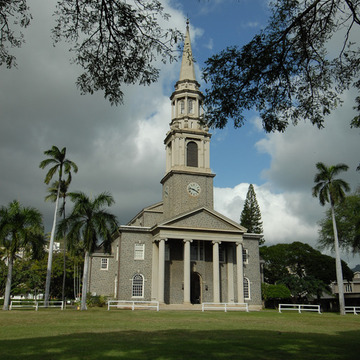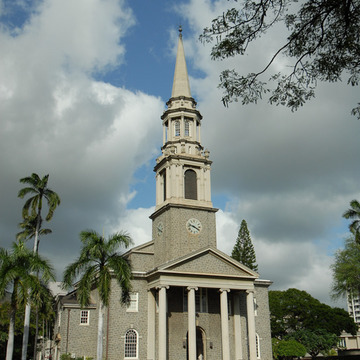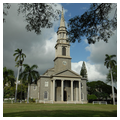Erected as a tribute to the early New England missionaries, ancestors of many in the congregation, Central Union Church is what Kawaiahao Church (OA58) aspired to be. It mattered little that Cram, Boston's preeminent architect of his era, strongly advocated the Gothic Revival as the proper ecclesiastical style. The congregation's desire to evoke memories of Protestant Hawaii's New England heritage was first and foremost in everyone's mind.
Sitting on an eight-acre lot, the equivalent of a village green, this superb Georgian Revival church in the Christopher Wren–James Gibbs tradition dominated the skyline of eastern Honolulu until the 1960s–1970s high-rise boom. In addition to its strong New England ties, the church is also grounded in Hawaii. The lava rock for the building was procured from the quarry in Moiliili, where the University of Hawaii's lower campus is now situated. The interior's twelve Corinthian columns substitute pineapple and palm leaves for acanthus. More important, five sets of French doors on each side wall open up the nave and its high, barrel-vaulted ceiling to the outdoors. Round-arched, second-story windows and recessed clerestory windows further contribute to the interior's light and airy atmosphere.
The origins of Central Union Church go back to 1832 when the Oahu Bethel Church was formed, offering the first regular Christian services in English in the Islands. Primarily serving seamen in port, its membership also included foreign residents. With an increasing number of sailors in port, Honolulu residents formed the Second Foreign Church in 1853 for their own use, which in 1856 became the Fort Street Church. A year after the Chinatown fire of 1886 consumed Bethel Church, the Fort Street and Bethel congregations united and constructed the Central Union Church at the corner of Beretania and Richards streets (demolished). Outgrowing their Romanesque Revival building and seeking relief from the noise and crowded city center, the congregation decided in 1922 to build the present church. The cornerstone of the 1891 predecessor is embedded high on the wall of the narthex.












